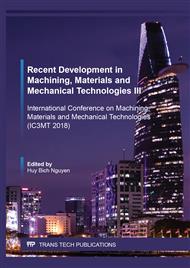p.39
p.45
p.51
p.56
p.62
p.71
p.77
p.84
p.92
Surface Roughening of Silicon Wafer Solar Cell by Using ECDM Method
Abstract:
This research proposes surface roughening of silicon wafer solar cell by electrochemical discharge machining (ECDM). The stainless steel was used as negative electrode. The graphite was used as the positive electrode acting as the auxiliary electrode. The potassium hydroxide was used as the electrolyte. The processing parameters include the machining voltage, the processing time, the machining gap, the electrolyte concentration, the additive agent concentration, pulse frequency and duty factor, etc. The result of experiments reveals that appropriate concentrations of ethanol can expand the size of the pores and enhance surface roughening effect. The appropriate processing parameters are a machining gap of 200μm, voltage of 48V, concentration of potassium hydroxide of 3M, concentration of ethanol of 4%. The electrochemical discharge machined surface roughness was increased from 0.417μm to 0.915μm using one minute processing time. The average reflectance rate of the textured surface was decreased from 29.6% to 12.7%. This study reveals that ECDM method has the advantage of short processing time and can generate a higher surface roughness and the porous structure.
Info:
Periodical:
Pages:
62-70
Citation:
Online since:
October 2019
Authors:
Price:
Сopyright:
© 2019 Trans Tech Publications Ltd. All Rights Reserved
Share:
Citation:


